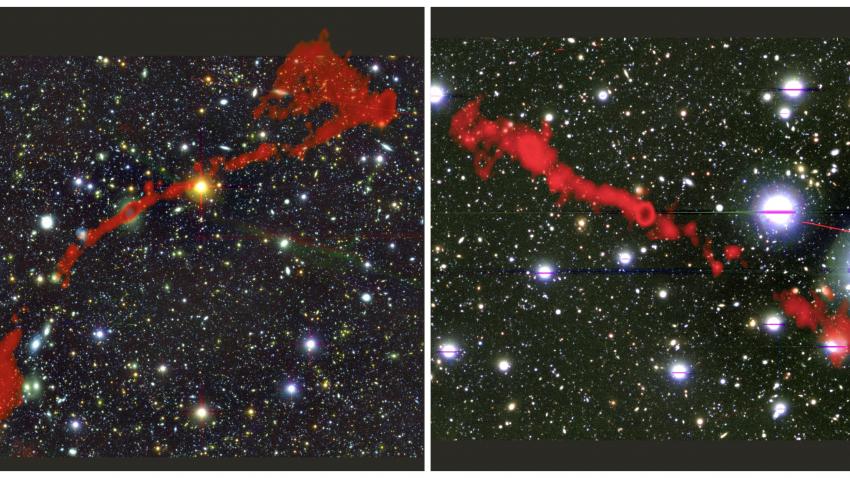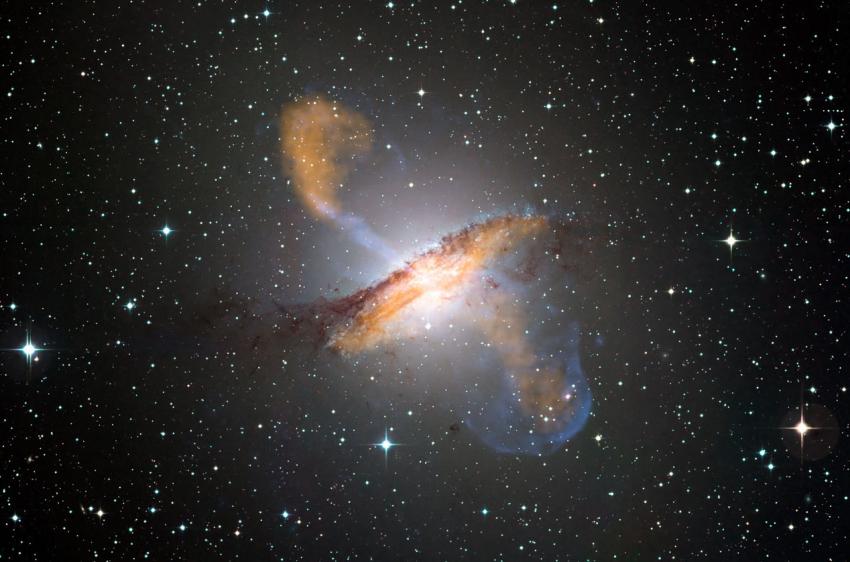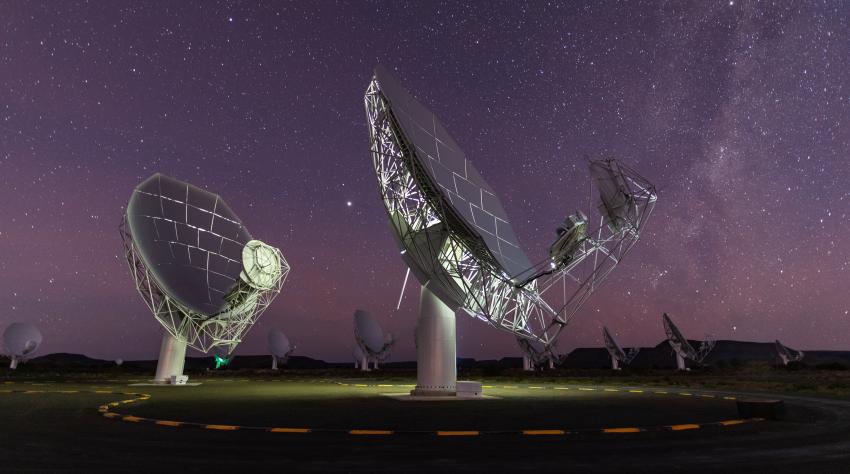Two giant radio galaxies have been discovered with South Africa's powerful MeerKAT telescope. These galaxies are thought to be amongst the largest single objects in the Universe. The discovery has been published today in Monthly Notices of the Royal Astronomical Society .
Whereas normal radio galaxies are fairly common, only a few hundred of these have radio jets exceeding 700 kilo-parsecs in size, or around 22 times the size of the Milky Way. These truly enormous systems are dubbed 'giant radio galaxies'.
Despite the scarcity of giant radio galaxies, the authors found two of these cosmic beasts in a remarkably small patch of sky.
Dr Jacinta Delhaize, a Research Fellow at the University of Cape Town and lead author of the work, said: "We found these giant radio galaxies in a region of sky which is only about 4 times the area of the full Moon. Based on our current knowledge of the density of giant radio galaxies in the sky, the probability of finding two of them in this region is less than 0.0003 per cent."
"This means that giant radio galaxies are probably far more common than we thought!"
Dr Matthew Prescott, a Research Fellow at the University of the Western Cape and co-author of the work, said, “These two galaxies are special because they are amongst the largest giants known, and in the top 10 per cent of all giant radio galaxies. They are more than 2 Mega-parsecs across, which is around 6.5 million light years or about 62 times the size of the Milky Way. Yet they are fainter than others of the same size."
"We suspect that many more galaxies like these should exist, because of the way we think galaxies grow and change over their lifetimes."
Why so few radio galaxies have such gigantic sizes remains something of a mystery. It is thought that the giants are the oldest radio galaxies, which have existed for long enough (several hundred million years) for their radio jets to grow outwards to these enormous sizes. If this is true, then many more giant radio galaxies should exist than are currently known.
The giant radio galaxies were spotted in new radio maps of the sky created by the MeerKAT International Gigahertz Tiered Extragalactic Exploration (MIGHTEE) survey. It is one of the large survey projects underway with South Africa's impressive MeerKAT radio telescope, a precursor to the Square Kilometre Array (SKA), which is due to become fully operational in the mid-2020s.
Dr Ian Heywood, a co-author at the University of Oxford, said "The MeerKAT telescope is the best of its kind in the world. We have managed to identify these giant radio galaxies for the first time because of MeerKAT's unprecedented sensitivity to faint and diffuse radio light."
Dr Delhaize adds, "In the past, this population of galaxies has been hidden from our 'sight' by the technical limitations of radio telescopes. However, it is now being revealed thanks to the impressive capabilities of the new generation of telescopes."
Construction of the highly anticipated trans-continental SKA telescope is due to commence in South Africa and Australia in 2021, and continue until 2027. Science commissioning observations could begin as early as 2023, and it is hoped that the telescope will reveal larger populations of radio galaxies than ever before and revolutionise our understanding of galaxy evolution.
Media contacts
Dr Morgan Hollis
Royal Astronomical Society
Mob: +44 (0)7802 877 700
press@ras.ac.uk
Dr Robert Massey
Royal Astronomical Society
Mob: +44 (0)7802 877 699
press@ras.ac.uk
Science contacts
Dr Jacinta Delhaize
Astronomy Department
University of Cape Town
jacinta@ast.uct.ac.za
Images and captions
Further information
The new work appears in, “MIGHTEE: Are giant radio galaxies more common than we thought?”, J. Delhaize, I. Heywood, M. Prescott, et al., Monthly Notices of the Royal Astronomical Society, 501 (3), pp. 3833-3845 (2021) (DOI: 10.1093/mnras/staa3837).
The paper is available from: https://doi.org/10.1093/mnras/staa3837
Notes for editors
The Royal Astronomical Society (RAS), founded in 1820, encourages and promotes the study of astronomy, solar-system science, geophysics and closely related branches of science. The RAS organises scientific meetings, publishes international research and review journals, recognises outstanding achievements by the award of medals and prizes, maintains an extensive library, supports education through grants and outreach activities and represents UK astronomy nationally and internationally. Its more than 4,400 members (Fellows), a third based overseas, include scientific researchers in universities, observatories and laboratories as well as historians of astronomy and others.
The RAS accepts papers for its journals based on the principle of peer review, in which fellow experts on the editorial boards accept the paper as worth considering. The Society issues press releases based on a similar principle, but the organisations and scientists concerned have overall responsibility for their content.
Follow the RAS on Twitter, Facebook, Instagram and YouTube
Download the RAS Podcast from Audioboom
MIGHTEE
The MeerKAT International Gigahertz Tiered Extragalactic Exploration (MIGHTEE) survey is a Large Survey Project being conducted with the MeerKAT telescope. Its overarching goal is to study the formation and evolution of galaxies. The principal investigators are Prof Matt Jarvis (University of Oxford) and Prof Russ Taylor (University of Cape Town, IDIA). Further details: http://idia.ac.za/mightee/
MeerKAT
The MeerKAT telescope is located in the Karoo region of South Africa and is comprised of 64 radio dishes. It was inaugurated in July 2018. MeerKAT is managed by the South African Radio Astronomy Observatory (SARAO), which is a facility of the National Research Foundation. Further details: https://www.sarao.ac.za/science/meerkat/





